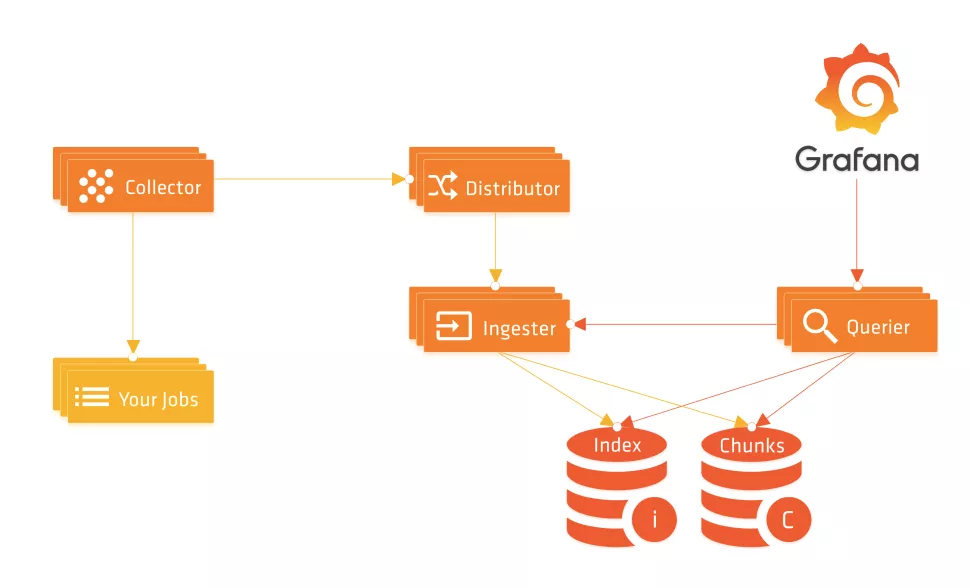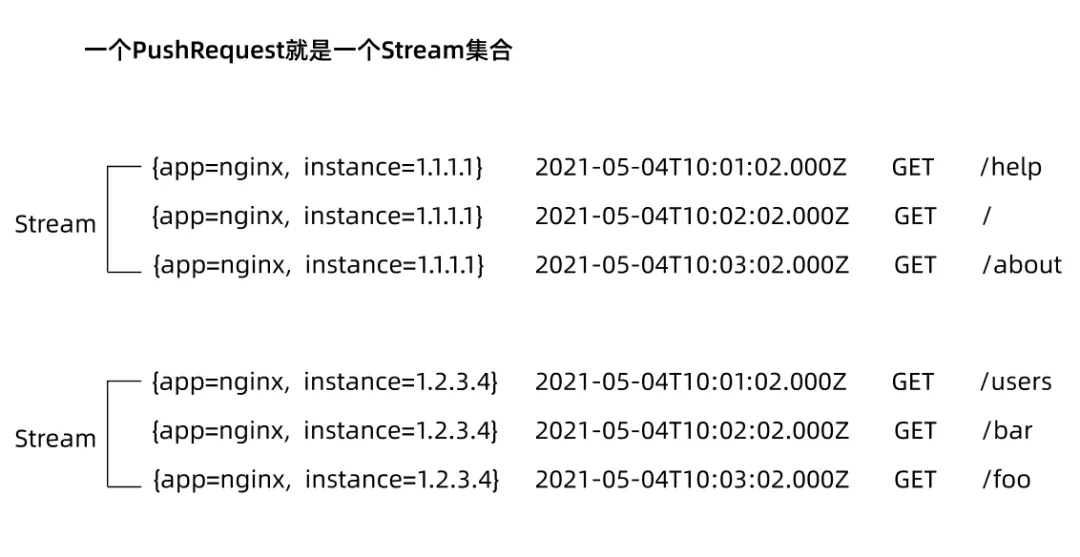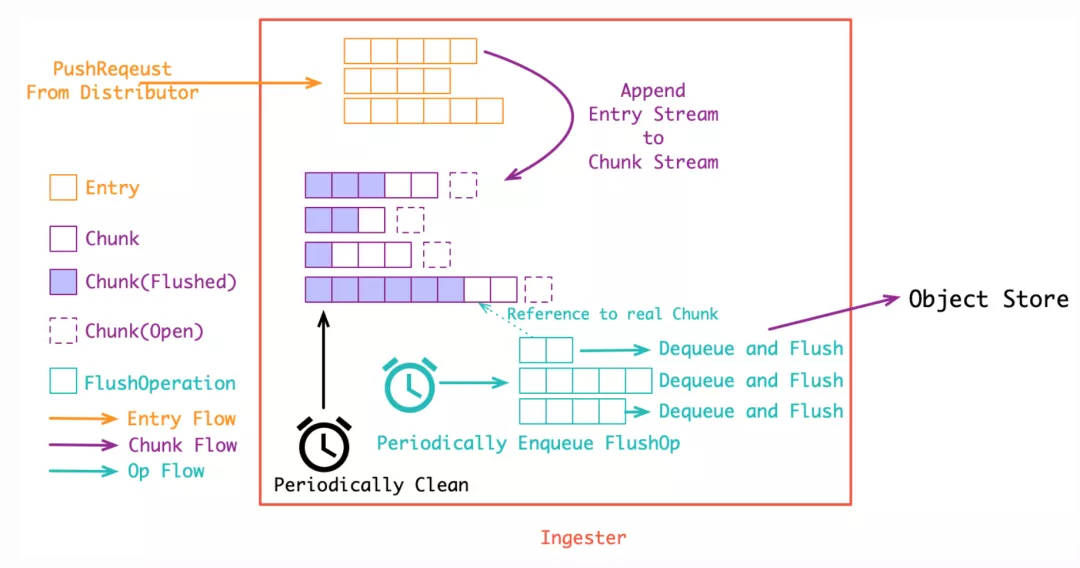CFSDN坚持开源创造价值,我们致力于搭建一个资源共享平台,让每一个IT人在这里找到属于你的精彩世界.
这篇CFSDN的博客文章Loki 源码分析之日志写入由作者收集整理,如果你对这篇文章有兴趣,记得点赞哟.
。
前面我们介绍了 Loki 的一些基本使用配置,但是对 Loki 还是了解不够深入,官方文档写得较为凌乱,而且没有跟上新版本,为了能够对 Loki 有一个更深入的认识,做到有的放矢,这里面我们尝试对 Loki 的源码进行一些简单的分析,由于有很多模块和实现细节,这里我们主要是对核心功能进行分析,希望对大家有所帮助。本文首先对日志的写入过程进行简单分析.

Distributor Push API
。
Promtail 通过 Loki 的 Push API 接口推送日志数据,该接口在初始化 Distributor 的时候进行初始化,在控制器基础上包装了两个中间件,其中的 HTTPAuthMiddleware 就是获取租户 ID,如果开启了认证配置,则从 X-Scope-OrgID 这个请求 Header 头里面获取,如果没有配置则用默认的 fake 代替.
- // pkg/loki/modules.go
- func (t *Loki) initDistributor() (services.Service, error) {
- ......
- if t.cfg.Target != All {
- logproto.RegisterPusherServer(t.Server.GRPC, t.distributor)
- }
-
- pushHandler := middleware.Merge(
- serverutil.RecoveryHTTPMiddleware,
- t.HTTPAuthMiddleware,
- ).Wrap(http.HandlerFunc(t.distributor.PushHandler))
-
- t.Server.HTTP.Handle("/api/prom/push", pushHandler)
- t.Server.HTTP.Handle("/loki/api/v1/push", pushHandler)
- return t.distributor, nil
- }
Push API 处理器实现如下所示,首先通过 ParseRequest 函数将 Http 请求转换成 logproto.PushRequest,然后直接调用 Distributor 下面的 Push 函数来推送日志数据:
- // pkg/distributor/http.go
-
- // PushHandler 从 HTTP body 中读取一个 snappy 压缩的 proto
- func (d *Distributor) PushHandler(w http.ResponseWriter, r *http.Request) {
- logger := util_log.WithContext(r.Context(), util_log.Logger)
- userID, _ := user.ExtractOrgID(r.Context())
- req, err := ParseRequest(logger, userID, r)
- ......
- _, err = d.Push(r.Context(), req)
- ......
- }
-
- func ParseRequest(logger gokit.Logger, userID string, r *http.Request) (*logproto.PushRequest, error) {
- var body lokiutil.SizeReader
- contentEncoding := r.Header.Get(contentEnc)
- switch contentEncoding {
- case "":
- body = lokiutil.NewSizeReader(r.Body)
- case "snappy":
- body = lokiutil.NewSizeReader(r.Body)
- case "gzip":
- gzipReader, err := gzip.NewReader(r.Body)
- if err != nil {
- return nil, err
- }
- defer gzipReader.Close()
- body = lokiutil.NewSizeReader(gzipReader)
- default:
- return nil, fmt.Errorf("Content-Encoding %q not supported", contentEncoding)
- }
-
- contentType := r.Header.Get(contentType)
- var req logproto.PushRequest
- ......
- switch contentType {
- case applicationJSON:
- var err error
- if loghttp.GetVersion(r.RequestURI) == loghttp.VersionV1 {
- err = unmarshal.DecodePushRequest(body, &req)
- } else {
- err = unmarshal_legacy.DecodePushRequest(body, &req)
- }
- if err != nil {
- return nil, err
- }
- default:
- // When no content-type header is set or when it is set to
- // `application/x-protobuf`: expect snappy compression.
- if err := util.ParseProtoReader(r.Context(), body, int(r.ContentLength), math.MaxInt32, &req, util.RawSnappy); err != nil {
- return nil, err
- }
- }
- return &req, nil
- }
首先我们先了解下 PushRequest 的结构,PushRequest 就是一个 Stream 集合:
- // pkg/logproto/logproto.pb.go
- type PushRequest struct {
- Streams []Stream `protobuf:"bytes,1,rep,name=streams,proto3,customtype=Stream" json:"streams"`
- }
-
- // pkg/logproto/types.go
- // Stream 流包含一个唯一的标签集,作为一个字符串,然后还包含一组日志条目
- type Stream struct {
- Labels string `protobuf:"bytes,1,opt,name=labels,proto3" json:"labels"`
- Entries []Entry `protobuf:"bytes,2,rep,name=entries,proto3,customtype=EntryAdapter" json:"entries"`
- }
-
- // Entry 是一个带有时间戳的日志条目
- type Entry struct {
- Timestamp time.Time `protobuf:"bytes,1,opt,name=timestamp,proto3,stdtime" json:"ts"`
- Line string `protobuf:"bytes,2,opt,name=line,proto3" json:"line"`
- }
。

然后查看 Distributor 下的 Push 函数实现:
- // pkg/distributor/distributor.go
- // Push 日志流集合
- func (d *Distributor) Push(ctx context.Context, req *logproto.PushRequest) (*logproto.PushResponse, error) {
- // 获取租户ID
- userID, err := user.ExtractOrgID(ctx)
- ......
-
- // 首先把请求平铺成一个样本的列表
- streams := make([]streamTracker, 0, len(req.Streams))
- keys := make([]uint32, 0, len(req.Streams))
- var validationErr error
- validatedSamplesSize := 0
- validatedSamplesCount := 0
-
- validationContext := d.validator.getValidationContextFor(userID)
-
- for _, stream := range req.Streams {
- // 解析日志流标签
- stream.Labels, err = d.parseStreamLabels(validationContext, stream.Labels, &stream)
- ......
- n := 0
- for _, entry := range stream.Entries {
- // 校验一个日志Entry实体
- if err := d.validator.ValidateEntry(validationContext, stream.Labels, entry); err != nil {
- validationErr = err
- continue
- }
- stream.Entries[n] = entry
- n++
- // 校验成功的样本大小和个数
- validatedSamplesSize += len(entry.Line)
- validatedSamplesCount++
- }
- // 去掉校验失败的实体
- stream.Entries = stream.Entries[:n]
-
- if len(stream.Entries) == 0 {
- continue
- }
- // 为当前日志流生成用于hash换的token值
- keys = append(keys, util.TokenFor(userID, stream.Labels))
- streams = append(streams, streamTracker{
- stream: stream,
- })
- }
-
- if len(streams) == 0 {
- return &logproto.PushResponse{}, validationErr
- }
-
- now := time.Now()
- // 每个租户有一个限速器,判断可以正常传输的日志大小是否应该被限制
- if !d.ingestionRateLimiter.AllowN(now, userID, validatedSamplesSize) {
- // 返回429表明客户端被限速了
- ......
- return nil, httpgrpc.Errorf(http.StatusTooManyRequests, validation.RateLimitedErrorMsg, int(d.ingestionRateLimiter.Limit(now, userID)), validatedSamplesCount, validatedSamplesSize)
- }
-
- const maxExpectedReplicationSet = 5 // typical replication factor 3 plus one for inactive plus one for luck
- var descs [maxExpectedReplicationSet]ring.InstanceDesc
-
- samplesByIngester := map[string][]*streamTracker{}
- ingesterDescs := map[string]ring.InstanceDesc{}
- for i, key := range keys {
- // ReplicationSet 描述了一个指定的键与哪些 Ingesters 进行对话,以及可以容忍多少个错误
- // 根据 label hash 到 hash 环上获取对应的 ingester 节点,一个节点可能有多个对等的 ingester 副本来做 HA
- replicationSet, err := d.ingestersRing.Get(key, ring.Write, descs[:0], nil, nil)
- ......
- // 最小成功的实例树
- streams[i].minSuccess = len(replicationSet.Ingesters) - replicationSet.MaxErrors
- // 可容忍的最大故障实例数
- streams[i].maxFailures = replicationSet.MaxErrors
- // 将 Stream 按对应的 ingester 进行分组
- for _, ingester := range replicationSet.Ingesters {
- // 配置每个 ingester 副本对应的日志流数据
- samplesByIngester[ingester.Addr] = append(samplesByIngester[ingester.Addr], &streams[i])
- ingesterDescs[ingester.Addr] = ingester
- }
- }
-
- tracker := pushTracker{
- done: make(chan struct{}),
- err: make(chan error),
- }
- tracker.samplesPending.Store(int32(len(streams)))
- // 循环Ingesters
- for ingester, samples := range samplesByIngester {
- // 让ingester并行处理通过hash环对应的日志流列表
- go func(ingester ring.InstanceDesc, samples []*streamTracker) {
- ......
- // 将日志流样本数据下发给对应的 ingester 节点
- d.sendSamples(localCtx, ingester, samples, &tracker)
- }(ingesterDescs[ingester], samples)
- }
- ......
- }
Push 函数的核心就是根据日志流的标签来计算一个 Token 值,根据这个 Token 值去哈希环上获取对应的处理日志的 Ingester 实例,然后并行通过 Ingester 处理日志流数据,通过 sendSamples 函数为单个 ingester 去发送日志样本数据:
- // pkg/distributor/distributor.go
-
- func (d *Distributor) sendSamples(ctx context.Context, ingester ring.InstanceDesc, streamTrackers []*streamTracker, pushTracker *pushTracker) {
- err := d.sendSamplesErr(ctx, ingester, streamTrackers)
- ......
- }
-
- func (d *Distributor) sendSamplesErr(ctx context.Context, ingester ring.InstanceDesc, streams []*streamTracker) error {
- // 根据 ingester 地址获取 client
- c, err := d.pool.GetClientFor(ingester.Addr)
- ......
- // 重新构造 PushRequest
- req := &logproto.PushRequest{
- Streams: make([]logproto.Stream, len(streams)),
- }
- for i, s := range streams {
- req.Streams[i] = s.stream
- }
- // 通过 Ingester 客户端请求数据
- _, err = c.(logproto.PusherClient).Push(ctx, req)
- ......
- }
Ingester 写入日志
。
Ingester 客户端中的 Push 函数实际上就是一个 gRPC 服务的客户端:
- // pkg/ingester/ingester.go
-
- // Push 实现 logproto.Pusher.
- func (i *Ingester) Push(ctx context.Context, req *logproto.PushRequest) (*logproto.PushResponse, error) {
- // 获取租户ID
- instanceID, err := user.ExtractOrgID(ctx)
- ......
- // 根据租户ID获取 instance 对象
- instance := i.getOrCreateInstance(instanceID)
- // 直接调用 instance 对象 Push 数据
- err = instance.Push(ctx, req)
- return &logproto.PushResponse{}, err
- }
instance 下的 Push 函数:
- // pkg/ingester/instance.go
-
- func (i *instance) Push(ctx context.Context, req *logproto.PushRequest) error {
- record := recordPool.GetRecord()
- record.UserID = i.instanceID
- defer recordPool.PutRecord(record)
-
- i.streamsMtx.Lock()
- defer i.streamsMtx.Unlock()
-
- var appendErr error
- for _, s := range req.Streams {
- // 获取一个 stream 对象
- stream, err := i.getOrCreateStream(s, false, record)
- if err != nil {
- appendErr = err
- continue
- }
- // 真正用于数据处理的是 stream 对象中的 Push 函数
- if _, err := stream.Push(ctx, s.Entries, record); err != nil {
- appendErr = err
- continue
- }
- }
- ......
- return appendErr
- }
-
- func (i *instance) getOrCreateStream(pushReqStream logproto.Stream, lock bool, record *WALRecord) (*stream, error) {
- if lock {
- i.streamsMtx.Lock()
- defer i.streamsMtx.Unlock()
- }
- // 如果 streams 中包含当前标签列表对应的 stream 对象,则直接返回
- stream, ok := i.streams[pushReqStream.Labels]
- if ok {
- return stream, nil
- }
- // record 只在重放 WAL 时为 nil
- // 我们不希望在重放 WAL 后丢掉数据
- // 为 instance 降低 stream 流限制
- var err error
- if record != nil {
- // 限流器判断
- // AssertMaxStreamsPerUser 确保与当前输入的流数量没有达到限制
- err = i.limiter.AssertMaxStreamsPerUser(i.instanceID, len(i.streams))
- }
- ......
- // 解析日志流标签集
- labels, err := logql.ParseLabels(pushReqStream.Labels)
- ......
- // 获取对应标签集的指纹
- fp := i.getHashForLabels(labels)
- // 重新实例化一个 stream 对象,这里还会维护日志流的倒排索引
- sortedLabels := i.index.Add(client.FromLabelsToLabelAdapters(labels), fp)
- stream = newStream(i.cfg, fp, sortedLabels, i.metrics)
- // 将stream设置到streams中去
- i.streams[pushReqStream.Labels] = stream
- i.streamsByFP[fp] = stream
-
- // 当重放 wal 的时候 record 是 nil (我们不希望在重放时重写 wal entries).
- if record != nil {
- record.Series = append(record.Series, tsdb_record.RefSeries{
- Ref: uint64(fp),
- Labels: sortedLabels,
- })
- } else {
- // 如果 record 为 nil,这就是一个 WAL 恢复
- i.metrics.recoveredStreamsTotal.Inc()
- }
- ......
- i.addTailersToNewStream(stream)
- return stream, nil
- }
这个里面涉及到 WAL 这一块的设计,比较复杂,我们可以先看 stream 下面的 Push 函数实现,主要就是将收到的 []Entry 先 Append 到内存中的 Chunk 流([]chunkDesc) 中:
- // pkg/ingester/stream.go
- func (s *stream) Push(ctx context.Context, entries []logproto.Entry, record *WALRecord) (int, error) {
- s.chunkMtx.Lock()
- defer s.chunkMtx.Unlock()
- var bytesAdded int
- prevNumChunks := len(s.chunks)
- var lastChunkTimestamp time.Time
- // 如果之前的 chunks 列表为空,则创建一个新的 chunk
- if prevNumChunks == 0 {
- s.chunks = append(s.chunks, chunkDesc{
- chunk: s.NewChunk(),
- })
- chunksCreatedTotal.Inc()
- } else {
- // 获取最新一个chunk的日志时间戳
- _, lastChunkTimestamp = s.chunks[len(s.chunks)-1].chunk.Bounds()
- }
-
- var storedEntries []logproto.Entry
- failedEntriesWithError := []entryWithError{}
-
- for i := range entries {
- // 如果这个日志条目与我们最后 append 的一行的时间戳和内容相匹配,则忽略它
- if entries[i].Timestamp.Equal(s.lastLine.ts) && entries[i].Line == s.lastLine.content {
- continue
- }
-
- // 最新的一个 chunk
- chunk := &s.chunks[len(s.chunks)-1]
- // 如果当前chunk已经关闭 或者 已经达到设置的最大 Chunk 大小
- if chunk.closed || !chunk.chunk.SpaceFor(&entries[i]) || s.cutChunkForSynchronization(entries[i].Timestamp, lastChunkTimestamp, chunk, s.cfg.SyncPeriod, s.cfg.SyncMinUtilization) {
- // 如果 chunk 没有更多的空间,则调用 Close 来以确保 head block 中的数据都被切割和压缩。
- err := chunk.chunk.Close()
- ......
- chunk.closed = true
- ......
- // Append 一个新的 Chunk
- s.chunks = append(s.chunks, chunkDesc{
- chunk: s.NewChunk(),
- })
- chunk = &s.chunks[len(s.chunks)-1]
- lastChunkTimestamp = time.Time{}
- }
- // 往 chunk 里面 Append 日志数据
- if err := chunk.chunk.Append(&entries[i]); err != nil {
- failedEntriesWithError = append(failedEntriesWithError, entryWithError{&entries[i], err})
- } else {
- // 存储添加到 chunk 中的日志数据
- storedEntries = append(storedEntries, entries[i])
- // 配置最后日志行的数据
- lastChunkTimestamp = entries[i].Timestamp
- s.lastLine.ts = lastChunkTimestamp
- s.lastLine.content = entries[i].Line
- // 累计大小
- bytesAdded += len(entries[i].Line)
- }
- chunk.lastUpdated = time.Now()
- }
-
- if len(storedEntries) != 0 {
- // 当重放 wal 的时候 record 将为 nil(我们不希望在重放的时候重写wal日志条目)
- if record != nil {
- record.AddEntries(uint64(s.fp), storedEntries...)
- }
- // 后续是用与tail日志的处理
- ......
- }
- ......
- // 如果新增了chunks
- if len(s.chunks) != prevNumChunks {
- memoryChunks.Add(float64(len(s.chunks) - prevNumChunks))
- }
- return bytesAdded, nil
- }
Chunk 其实就是多条日志构成的压缩包,将日志压成 Chunk 的可以直接存入对象存储, 一个 Chunk 到达指定大小之前会不断 Append 新的日志到里面,而在达到大小之后, Chunk 就会关闭等待持久化(强制持久化也会关闭 Chunk, 比如关闭 ingester 实例时就会关闭所有的 Chunk 并持久化)。Chunk 的大小控制很重要:
- 假如 Chunk 容量过小: 首先是导致压缩效率不高,同时也会增加整体的 Chunk 数量, 导致倒排索引过大,最后, 对象存储的操作次数也会变多, 带来额外的性能开销
- 假如 Chunk 过大: 一个 Chunk 的 open 时间会更长, 占用额外的内存空间, 同时, 也增加了丢数据的风险,Chunk 过大也会导致查询读放大

(图片来源: https://aleiwu.com/post/grafana-loki/) 。
在将日志流追加到 Chunk 中过后,在 Ingester 初始化时会启动两个循环去处理 Chunk 数据,分别从 chunks 数据取出存入优先级队列,另外一个循环定期检查从内存中删除已经持久化过后的数据.
首先是 Ingester 中定义了一个 flushQueues 属性,是一个优先级队列数组,该队列中存放的是 flushOp:
- // pkg/ingester/ingester.go
- type Ingester struct {
- services.Service
- ......
- // 每个 flush 线程一个队列,指纹用来选择队列
- flushQueues []*util.PriorityQueue // 优先级队列数组
- flushQueuesDone sync.WaitGroup
- ......
- }
-
- // pkg/ingester/flush.go
- // 优先级队列中存放的数据
- type flushOp struct {
- from model.Time
- userID string
- fp model.Fingerprint
- immediate bool
- }
在初始化 Ingester 的时候会根据传递的 ConcurrentFlushes 参数来实例化 flushQueues的大小:
- // pkg/ingester/ingester.go
- func New(cfg Config, clientConfig client.Config, store ChunkStore, limits *validation.Overrides, configs *runtime.TenantConfigs, registerer prometheus.Registerer) (*Ingester, error) {
- ......
- i := &Ingester{
- ......
- flushQueues: make([]*util.PriorityQueue, cfg.ConcurrentFlushes),
- ......
- }
- ......
- i.Service = services.NewBasicService(i.starting, i.running, i.stopping)
- return i, nil
- }
然后通过 services.NewBasicService 实例化 Service 的时候指定了服务的 Starting、Running、Stopping 3 个状态,在其中的 staring 状态函数中会启动协程去消费优先级队列中的数据 。
- // pkg/ingester/ingester.go
- func (i *Ingester) starting(ctx context.Context) error {
- // todo,如果开启了 WAL 的处理
- ......
- // 初始化 flushQueues
- i.InitFlushQueues()
- ......
- // 启动循环检查chunk数据
- i.loopDone.Add(1)
- go i.loop()
- return nil
- }
初始化 flushQueues 实现如下所示,其中 flushQueuesDone 是一个 WaitGroup,根据配置的并发数量并发执行 flushLoop 操作:
- // pkg/ingester/flush.go
- func (i *Ingester) InitFlushQueues() {
- i.flushQueuesDone.Add(i.cfg.ConcurrentFlushes)
- for j := 0; j < i.cfg.ConcurrentFlushes; j++ {
- // 为每个协程构造一个优先级队列
- i.flushQueues[j] = util.NewPriorityQueue(flushQueueLength)
- go i.flushLoop(j)
- }
- }
每一个优先级队列循环消费数据:
- // pkg/ingester/flush.go
- func (i *Ingester) flushLoop(j int) {
- ......
- for {
- // 从队列中根据优先级取出数据
- o := i.flushQueues[j].Dequeue()
- if o == nil {
- return
- }
- op := o.(*flushOp)
- // 执行真正的刷新用户序列数据
- err := i.flushUserSeries(op.userID, op.fp, op.immediate)
- ......
- // 如果退出时刷新失败了,把失败的操作放回到队列中去。
- if op.immediate && err != nil {
- op.from = op.from.Add(flushBackoff)
- i.flushQueues[j].Enqueue(op)
- }
- }
- }
刷新用户的序列操作,也就是要保存到存储中去:
- // pkg/ingester/flush.go
- // 根据用户ID刷新用户日志序列
- func (i *Ingester) flushUserSeries(userID string, fp model.Fingerprint, immediate bool) error {
- instance, ok := i.getInstanceByID(userID)
- ......
- // 根据instance和fp指纹数据获取需要刷新的chunks
- chunks, labels, chunkMtx := i.collectChunksToFlush(instance, fp, immediate)
- ......
- // 执行真正的刷新 chunks 操作
- err := i.flushChunks(ctx, fp, labels, chunks, chunkMtx)
- ......
- }
-
- // 收集需要刷新的 chunks
- func (i *Ingester) collectChunksToFlush(instance *instance, fp model.Fingerprint, immediate bool) ([]*chunkDesc, labels.Labels, *sync.RWMutex) {
- instance.streamsMtx.Lock()
- // 根据指纹数据获取 stream
- stream, ok := instance.streamsByFP[fp]
- instance.streamsMtx.Unlock()
- if !ok {
- return nil, nil, nil
- }
-
- var result []*chunkDesc
- stream.chunkMtx.Lock()
- defer stream.chunkMtx.Unlock()
- // 循环所有chunks
- for j := range stream.chunks {
- // 判断是否应该刷新当前chunk
- shouldFlush, reason := i.shouldFlushChunk(&stream.chunks[j])
- if immediate || shouldFlush {
- // 确保不再对该块进行写操作(如果没有关闭,则设置为关闭状态)
- if !stream.chunks[j].closed {
- stream.chunks[j].closed = true
- }
- // 如果该 chunk 还没有被成功刷新,则刷新这个块
- if stream.chunks[j].flushed.IsZero() {
- result = append(result, &stream.chunks[j])
- ......
- }
- }
- }
- return result, stream.labels, &stream.chunkMtx
- }
下面是判断一个具体的 chunk 是否应该被刷新的逻辑:
- // pkg/ingester/flush.go
- func (i *Ingester) shouldFlushChunk(chunk *chunkDesc) (bool, string) {
- // chunk关闭了也应该刷新了
- if chunk.closed {
- if chunk.synced {
- return true, flushReasonSynced
- }
- return true, flushReasonFull
- }
- // chunk最后更新的时间超过了配置的 chunk 空闲时间 MaxChunkIdle
- if time.Since(chunk.lastUpdated) > i.cfg.MaxChunkIdle {
- return true, flushReasonIdle
- }
-
- // chunk的边界时间操过了配置的 chunk 最大时间 MaxChunkAge
- if from, to := chunk.chunk.Bounds(); to.Sub(from) > i.cfg.MaxChunkAge {
- return true, flushReasonMaxAge
- }
- return false, ""
- }
真正将 chunks 数据刷新保存到存储中是 flushChunks 函数实现的:
- // pkg/ingester/flush.go
- func (i *Ingester) flushChunks(ctx context.Context, fp model.Fingerprint, labelPairs labels.Labels, cs []*chunkDesc, chunkMtx sync.Locker) error {
- ......
- wireChunks := make([]chunk.Chunk, len(cs))
- // 下面的匿名函数用于生成保存到存储中的chunk数据
- err = func() error {
- chunkMtx.Lock()
- defer chunkMtx.Unlock()
-
- for j, c := range cs {
- if err := c.chunk.Close(); err != nil {
- return err
- }
- firstTime, lastTime := loki_util.RoundToMilliseconds(c.chunk.Bounds())
- ch := chunk.NewChunk(
- userID, fp, metric,
- chunkenc.NewFacade(c.chunk, i.cfg.BlockSize, i.cfg.TargetChunkSize),
- firstTime,
- lastTime,
- )
-
- chunkSize := c.chunk.BytesSize() + 4*1024 // size + 4kB should be enough room for cortex header
- start := time.Now()
- if err := ch.EncodeTo(bytes.NewBuffer(make([]byte, 0, chunkSize))); err != nil {
- return err
- }
- wireChunks[j] = ch
- }
- return nil
- }()
-
-
- // 通过 store 接口保存 chunk 数据
- if err := i.store.Put(ctx, wireChunks); err != nil {
- return err
- }
-
- ......
-
- chunkMtx.Lock()
- defer chunkMtx.Unlock()
- for i, wc := range wireChunks {
- // flush 成功,写入刷新时间
- cs[i].flushed = time.Now()
- // 下是一些监控数据更新
- ......
- }
-
- return nil
- }
chunk 数据被写入到存储后,还有有一个协程会去定时清理本地的这些 chunk 数据,在上面的 Ingester 的 staring 函数中最后有一个 go i.loop(),在这个 loop() 函数中会每隔 FlushCheckPeriod(默认 30s,可以通过 --ingester.flush-check-period 进行配置)时间就会去去调用 sweepUsers 函数进行垃圾回收:
- // pkg/ingester/ingester.go
- func (i *Ingester) loop() {
- defer i.loopDone.Done()
-
- flushTicker := time.NewTicker(i.cfg.FlushCheckPeriod)
- defer flushTicker.Stop()
-
- for {
- select {
- case <-flushTicker.C:
- i.sweepUsers(false, true)
- case <-i.loopQuit:
- return
- }
- }
- }
sweepUsers 函数用于执行将日志流数据加入到优先级队列中,并对没有序列的用户进行垃圾回收:
- // pkg/ingester/flush.go
- // sweepUsers 定期执行 flush 操作,并对没有序列的用户进行垃圾回收
- func (i *Ingester) sweepUsers(immediate, mayRemoveStreams bool) {
- instances := i.getInstances()
- for _, instance := range instances {
- i.sweepInstance(instance, immediate, mayRemoveStreams)
- }
- }
-
- func (i *Ingester) sweepInstance(instance *instance, immediate, mayRemoveStreams bool) {
- instance.streamsMtx.Lock()
- defer instance.streamsMtx.Unlock()
- for _, stream := range instance.streams {
- i.sweepStream(instance, stream, immediate)
- i.removeFlushedChunks(instance, stream, mayRemoveStreams)
- }
- }
-
- // must hold streamsMtx
- func (i *Ingester) sweepStream(instance *instance, stream *stream, immediate bool) {
- stream.chunkMtx.RLock()
- defer stream.chunkMtx.RUnlock()
- if len(stream.chunks) == 0 {
- return
- }
- // 最新的chunk
- lastChunk := stream.chunks[len(stream.chunks)-1]
- // 判断是否应该被flush
- shouldFlush, _ := i.shouldFlushChunk(&lastChunk)
- // 如果只有一个chunk并且不是强制持久化切最新的chunk还不应该被flush,则直接返回
- if len(stream.chunks) == 1 && !immediate && !shouldFlush {
- return
- }
- // 根据指纹获取用与处理的优先级队列索引
- flushQueueIndex := int(uint64(stream.fp) % uint64(i.cfg.ConcurrentFlushes))
- firstTime, _ := stream.chunks[0].chunk.Bounds()
- // 加入到优先级队列中去
- i.flushQueues[flushQueueIndex].Enqueue(&flushOp{
- model.TimeFromUnixNano(firstTime.UnixNano()), instance.instanceID,
- stream.fp, immediate,
- })
- }
-
- // 移除已经flush过后的chunks数据
- func (i *Ingester) removeFlushedChunks(instance *instance, stream *stream, mayRemoveStream bool) {
- now := time.Now()
-
- stream.chunkMtx.Lock()
- defer stream.chunkMtx.Unlock()
- prevNumChunks := len(stream.chunks)
- var subtracted int
- for len(stream.chunks) > 0 {
- // 如果chunk还没有被刷新到存储 或者 chunk被刷新到存储到现在的时间还没操过 RetainPeriod(默认15分钟,可以通过
- if stream.chunks[0].flushed.IsZero() || now.Sub(stream.chunks[0].flushed) < i.cfg.RetainPeriod {
- break
- }
- subtracted += stream.chunks[0].chunk.UncompressedSize()
- // 删除引用,以便该块可以被垃圾回收起来
- stream.chunks[0].chunk = nil
- // 移除chunk
- stream.chunks = stream.chunks[1:]
- }
- ......
- // 如果stream中的所有chunk都被清空了,则清空该 stream 的相关数据
- if mayRemoveStream && len(stream.chunks) == 0 {
- delete(instance.streamsByFP, stream.fp)
- delete(instance.streams, stream.labelsString)
- instance.index.Delete(stream.labels, stream.fp)
- ......
- }
- }
关于存储或者查询等模块的实现在后文再继续探索,包括 WAL 的实现也较为复杂.
原文链接:https://mp.weixin.qq.com/s/9BKZvNANqGJwziygytJ1ag 。
最后此篇关于Loki 源码分析之日志写入的文章就讲到这里了,如果你想了解更多关于Loki 源码分析之日志写入的内容请搜索CFSDN的文章或继续浏览相关文章,希望大家以后支持我的博客! 。




我是一名优秀的程序员,十分优秀!